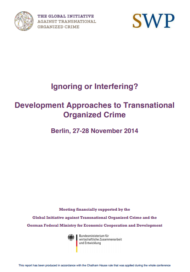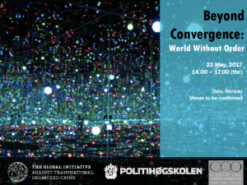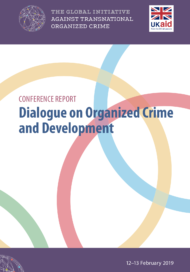Posted on 05 Feb 2015
Organized crime is increasingly seen as having implications broader than the traditional frameworks of security and justice, but also severely impacting on the capacity to achieve basic social and economic development objectives for the vast majority of vulnerable and marginalized people in the world. The process of developing the post-2015 Sustainable Development Goal (SDG) framework represents a singular opportunity to make explicit the link between organised crime and development and provide a mandate for development actors to address organized crime and mitigate its impact, but the means by which this can be practically achieved are not yet clear.
In order to better understand and respond to organised crime as a development challenge, the Global Initiative has been working with a series of partners to convene a Development Dialogue: a forum convening key members of the international development community with the objective of sharing knowledge and experience, facilitating common approaches and developing tools to address organized crime.
This report summarises the discussions in a two day event co-hosted by the Stiftung Wissenschaft und Politik (SWP) and the Global Initiative in Berlin on the 27-8 November 2014, convened under the Chatham House rule. The goal of the meeting, which drew together more than 40 policymakers and analysts, was to further interrogate the practical implications of responding to organized crime as a development challenge, and to identify lessons learned and best practices that may be used as guidance towards the design of further integrated approaches.
The discussion concluded with a number of recommendations for how the development community might be better engaged, and the quality of responses might be improved:
1. Building a better evidence basis
There was a general sense that there is not enough analytical work being done to underpin and justify policymaking around organized crime from a development perspective. In those areas – such as environmental crime – where the impact and the link to development is more obvious, half the battle is won. However, in other contexts development partners still need to be convinced to get engaged. Bilateral donors would see value in improved data collection and analysis from the research and policy institutes focused on these issues. While describing the problem and publishing large and shocking numbers to attract attention has some value in raising awareness, studies of this kind often fail to provide practical recommendations regarding how to respond, which link the analysis to the ramifications for development assistance.
2. Designing responses for a development audience
Typically even where innovative analysis might be done, the resulting recommendations on programmatic responses fall into the same formulas of buying more expensive surveillance equipment, upgrading infrastructure, or build capacity of law enforcement and customs officials. This does little to convince development actors that they need to do things differently. Development donors and practitioners need more practical guidance on how things can be done within areas they are comfortable working in. Some nascent good practices and lessons learned were identified in this meeting, for example, and there is a clear need for these to be documented and disseminated to inform efforts in other jurisdictions and contexts. Several participants noted that development donors would welcome examples of what integrated approaches would look like in various project areas.
3. Strengthen the analytical framework
A number of participants noted that the policy sector around organized crime lacks a dynamism that has coalesced around other key debates, for example human rights or gender mainstreaming. The advocacy pressure is not being put on donors in the way it has on other issues, and common tools, approaches, principles or strategies are missing to underpin efforts. Caution was expressed, however, in pushing too hard to “mainstream” organized crime. While a crime sensitive approach may be the requirement, there is a certain fatigue amongst development practitioners towards mainstreaming, and it often results in an issue being overlooked rather than emphasised.
4. Measure impact
A frequently repeated constraint in programming to counter organized crime is the challenge of measuring the impact. As the SDG discussions move forward into establishing targets, the capacity to measure progress will become more pressing. If actors cannot put forward a credible framework of indicators to measure the impact of interventions in a particular area, they will struggle to convince donors that such interventions are credible and feasible. The Global Initiative’s report, “Organized Crime: a cross-cutting threat to sustainable development” has proven that it is important to recognize opportunities to integrate efforts to counter organized crime across the Sustainable Development Goals. Thus, within each of the development goals, putting in place a matrix of indicators and benchmarks will be necessary to measure the extent of criminal penetration and its impact on development objectives might be necessary. Both of the analytical framework presentations accompany reports that have proposed indicators. There are in addition many other reports circulating which examine the implementation of the goals and indicators for measurement. Selecting an effective basket of measurement tools will be important, and continued advocacy and sensitization is required.
5. Bridge the gap
A number of the participants had been involved in the Development Dialogue process run by the Global Initiative since its inception a year previously, and remarked on the degree to which debates have progressed. Clearly, the development community is much more proactively engaged and aware of the issues now, and the emergence of programming in this area is a positive indicator. Participants encouraged to continue the Dialogue, but to look towards increasing the participation of security sector representatives, thereby furthering the development of joint thinking, sharing of experiences and approaches, and eventual alignment of policy.
Photo by Abigail Keenan on Unsplash




